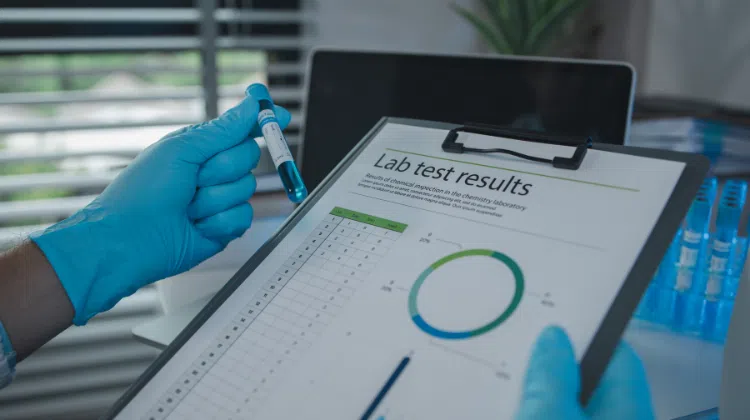
What is Kratom? The Complete Guide from Golden Monk
Introduction Kratom is a plant that inspires curiosity, debate, and misunderstanding. Some people hear about...
View PostYour cart is currently empty.
Continue ShoppingMenu
Cart
Your cart is currently empty.
Continue ShoppingSearch

Ever wondered what’s really in your Kratom? Lab test reports are the key to understanding the information. When Kratom is examined, the reports highlight the quality, purity, and overall integrity of the product you’re buying. However, the truth is that lab test reports can be overwhelming due to their technical terms and numerous differences. That’s where a guide to reading a Kratom test report can make the difference.
When you’re aware of how to read the Kratom lab report, you can easily evaluate between brand and their products. These reports discuss alkaloid levels, confirm purity, and verify the absence of harmful additives. Once you learn how to decode them, you’ll shop with confidence, knowing your Kratom meets the highest standards and comes from sources that value transparency.
Lab testing of Kratom is the process by which vendors or manufacturers analyze the product that contains Kratom. The products can be Kratom capsules, extracts, shots, or powder. During Kratom testing, researchers check for heavy metals and harmful pathogens while also analyzing its origin, alkaloid profile, and other key qualities.
Accredited third-party laboratories typically conduct laboratory testing, and in some cases, vendors collaborate with multiple testing companies. Many vendors also share their lab reports with customers, either by request or directly on their websites.
A Kratom lab report, often called a Certificate of Analysis (COA), is a scientific document that shows exactly what’s inside a product. Independent, third-party labs conduct these Kratom tests to confirm purity, check for contaminants, and measure key alkaloids such as mitragynine. Reliable reports also include details on heavy metals, microbial safety, and sometimes additional screenings, such as for solvents or pesticides.
Every credible report is linked to a specific batch or lot number, ensuring the results match the product you’re holding. This traceability is essential because older or generic reports may not reflect the actual batch being sold. In essence, a lab report provides clear proof and accountability, bridging the gap between vendor promises and scientific evidence.
Before Kratom ever makes its way to you, it undergoes strict Kratom lab testing. This process isn’t just about formality; it’s about verifying authenticity, removing potential risks, and ensuring each batch meets the same high standards. Here’s what testing checks for:
Testing ensures the product truly comes from Mitragyna speciosa. This step prevents mislabeling and confirms authenticity right from the start.
Labs check for elements like lead, cadmium, and arsenic. Left unchecked, these can build up and cause serious concerns over time.
Testing identifies harmful bacteria such as Staphylococcus aureus, Yeast, Molds, Coliforms, Salmonella, and E. coli. By finding these early, Kratom labs prevent potential outbreaks.
Lab reports reveal the levels of active compounds, including mitragynine and other alkaloids in kratom. This keeps potency consistent and avoids unwanted surprises.
Reading a Kratom lab report may feel overwhelming at first, but breaking it down makes it manageable. Begin by verifying that the lab information is from a third-party, accredited facility, rather than an in-house Kratom test. Next, look at the batch or lot number. This ties the report directly to the product in your hands, confirming traceability.
Move to the alkaloid profile, where mitragynine levels are listed. Excessively high or unusual values may signal tampering. Then, review safety screenings for heavy metals and microbes like Salmonella or E. coli. A trustworthy report should also show test dates, ensuring the analysis is recent. Finally, check for QR codes or links that let you verify authenticity yourself.
Kratom lab results offer valuable insight, but like any scientific testing, they aren’t flawless. Accuracy depends heavily on the lab’s accreditation, equipment quality, and sampling methods. For example, if only a small portion of a batch is tested, it may not represent the entire lot; hotspots of bacteria or uneven alkaloid distribution can be missed.
To get the clearest picture, look for recent, third-party reports tied to specific batch numbers and supported by full-panel testing. When labs follow strict protocols, reports are highly reliable, but as a buyer, it’s wise to double-check transparency tools like QR codes or verification links.
Through Kratom lab testing, you can see exactly what’s inside, alkaloid levels, microbial safety, and whether harmful substances like lead in Kratom are present. While no testing method is perfect, reports from accredited Kratom labs offer valuable transparency and batch-specific details. By learning how to read these reports, you separate marketing claims from scientific evidence. Whether you’re reviewing lab-tested Kratom or taking time to examine Kratom testing details, knowledge ensures you’re selecting products that meet the highest standards of quality and accountability.

Introduction Kratom is a plant that inspires curiosity, debate, and misunderstanding. Some people hear about...
View Post
Are you also confused about which Kratom form you should try for your busy schedule?...
View Post
When discussing ‘Kratom Tea vs Powder,’ you must understand that Kratom tea is brewed from...
View PostBy clicking yes you also confirm that you have read and agree to GoldenMonk's Terms of Service and Privacy Policy and Goldenmonks’s service provider’s terms of service and privacy policy.